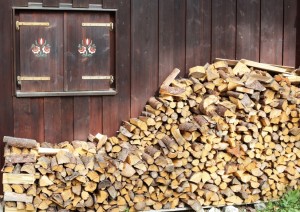Burn Notice
At ClimateCare, we love our gas fireplaces. But we recognize the appeal of your classic, wood-burning fireplace. Customers often ask us what type of wood they should burn as the primary fuel for their fireplace in the winter, and we’re happy to share. Some wood burns more efficiently than others, but might not be available in your area. Our recommendations are:
Your Top 3 Hard woods
 Don’t cut down that old pine tree in your yard and stack the wood for your fire. It’s too soft, and your fires will be sad. Hardwood is much better firewood. Not only will it burn longer, but it also produces more heat than softer woods. It also burns cleaner, leaving less creosote residue (and reducing your need for chimney sweeping services. There 3 hardwoods to rule your fireplace.
Don’t cut down that old pine tree in your yard and stack the wood for your fire. It’s too soft, and your fires will be sad. Hardwood is much better firewood. Not only will it burn longer, but it also produces more heat than softer woods. It also burns cleaner, leaving less creosote residue (and reducing your need for chimney sweeping services. There 3 hardwoods to rule your fireplace.
1. Oak
Oak is probably the nicest burning firewood available. Although it takes longer to dry than other types of wood, once it has dried it burns slowly and generates and incredible amount of heat. Oak difficult to ignite, so you should find a different type of wood as kindling to start the fire.
2. Birch
Birch is a great choice when you want quick heat. It ignites readily, looks great in a fireplace and generates an impressive amount of heat. But these qualities come at a cost. Birch wood will burn very quickly, requiring you to tend the fire often and stock much more fuel in your shed or garage. It’s a good kindling, and you could mix large logs with other wood to slow down the burning.
3. Maple
There are a lot of maple trees in the Northern Hemisphere and they’re a good choice when you’re looking for firewood. Maple actually has an even slower burn than Oak, though the blaze won’t be quite as hot. Mix all 3 woods above for a flame connoisseurs burn!
When soft woods are your only option
Soft woods never burn as well as hard woods. They leave behind more residue, so you will end up with more creosote buildup in your chimney than with hard wood. However, the flames will still look great, warm up your room and give you the ambiance you’re looking for. If softwood trees are plentiful where you live, opt for:
1. Pine
Red and White Pine can be used as a firewood. The advantage is that the wood is very easy to split and cure, and it burns nicely. The down side is that it also burns quite quickly and can often be full of sap pockets that can trigger sparks. The sound of crackling wood is great, but be careful the sap sparks don’t leap out to the surrounding carpet.
2. Douglas Fir
Some people love burning Douglas Fir. Like pine it’s easy to handle, but it also burns out quickly. The light density means oxygen feeds your flames, which eat up the wood ravenously.
 The secret is in the curing
The secret is in the curing
Type of wood is just one thing to consider before the coming winter. Before purchasing a cord, you need to make sure the firewood has been properly cured. When you burn wood that hasn’t been cured and is still quite green you’ll find it tends to generate more smoke than heat. The rule of thumb is that the wood needs to dry for 6-18 months before it’s burned. The best way to cure freshly cut firewood is stacking it in an area where it’s exposed to a great deal of wind and sun.
Signs that the firewood is dry and ready to burn include:
- There are visible cracks
- It appears faded
- You don’t feel any moisture
- Each piece weighs less than wood that has just been cut.
Using the proper firewood ensures that you’ll stay warm and toasty this winter!
Then again, installing a gas fireplace means you won’t have to worry about stacking, curing and storing your wood fuel. Start your fire with the push of a button! If that is more up your alley, get in touch with your local ClimateCare member today.




